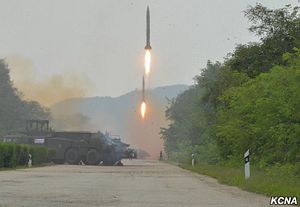Early on Monday, March 6, North Korea launched up to four ballistic missiles into the Sea of Japan, three of which landed within Japan’s exclusive economic zone (EEZ), according to the Japanese government. The test was the first ballistic missile launch from the country since its February 12 test launch of the Pukkuksong-2 solid-fuel, medium-range ballistic missile, and its second ballistic missile launch in 2017 overall.
According to South Korean military sources cited by Yonhap news, the as-yet unidentified ballistic missiles were launched “from an area near” the Tongchang-ri long-range missile testing site (also known as the Sohae Satellite Launching Station, where North Korea staged its Kwangmyongsong-4 satellite launch vehicle launch last February). The projectiles flew for at least 1,000 kilometers before splashing down in the Sea of Japan.
The choice of Tongchang-ri as the launch site for at least one of the missiles fired on Monday led to early speculation that North Korea had carried out its long-anticipated intercontinental ballistic missile test, involving either the KN-08 or KN-14. According to South Korea’s Ministry of Defense, Monday’s missiles demonstrated an apogee (highest point in their ballistic trajectory) of 260 kilometers, lower than the 1,000 kilometer apogee observed in last year’s successful Hwasong-10 intermediate-range ballistic missile test and the Pukkuksong-2’s 550 kilometer apogee in February.
Japan’s Chief Cabinet Secretary Yoshihide Suga, while corroborating that the missiles flew for 1,000 kilometers, said that the splashdown occurred within Japan’s EEZ, 250 kilometers west of Akita prefecture. Last year, for the first time, a North Korean Nodong missile splashed down in Japan’s EEZ, also off Akita prefecture.
U.S. Strategic Command noted that its “systems detected and tracked what we assess was a North Korean missile launch,” confirming just one of what South Korea and Japan have said was a four-missile salvo launch. “South Korea and the United States are conducting a close-up analysis, regarding further information,” South Korea’s Office of Joint Chiefs of Staff added in a statement.
“The launches are clearly in violation of (UN) Security Council resolutions. It is an extremely dangerous action,” Japanese Prime Minister Shinzo Abe said in the Japanese Diet. He added that Japan had lodged “strong protests” with North Korea.
The Trump White House has yet to release any statement on the launch, but U.S. State Department Acting Spokesperson Mark Toner noted that the United States “strongly condemns” the launch. “We remain prepared … to defend ourselves from attack, and are prepared to use the full range of capabilities at our disposal against this growing threat,” Toner emphasized.
Monday’s launch comes after days of warnings in the North Korean state media that Pyongyang would retaliate as the United States and South Korea begin their annual spring-time, large-scale military drills, including Foal Eagle, which kicked off last week, and Key Resolve, which will begin later this month. North Korea sees the drills as a rehearsal by the U.S.-South Korea alliance for a preemptive attack and has asked for the exercises to stop.
Monday marks the sixth day of this year’s Foal Eagle exercise. North Korean missile launches around the time of the annual U.S.-South Korea exercises are becoming something of a habit; last year, North Korea launched six short-range missiles as the exercises began.
The launch also comes as the Trump administration in the United States continues to conduct a review of U.S. policy toward North Korea. The administration is considering options ranging from the continuation of status quo U.S. policy focusing on punitive sanctions to preemptive military action to disarm North Korea of nuclear weapons and potentially even regime change.
































